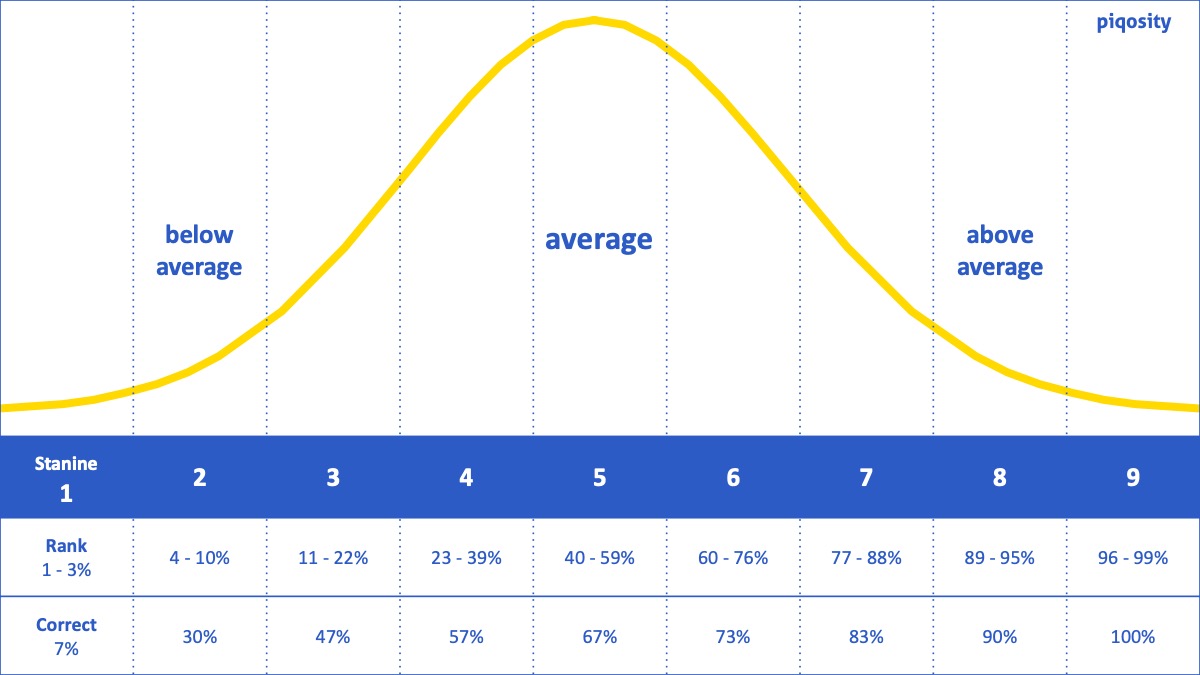The Independent School Entrance Exam (ISEE) Middle Level is a popular admissions test taken by American students applying to private US high schools for grades 7 & 8. It is developed and marketed by the non-profit Educational Records Bureau (ERB).
Students have about 3 hours to complete the 161-question ISEE, which is comprised of four separately scored sub-tests and a non-scored essay:
- Verbal Reasoning (20 minutes, 40 questions)
- Quantitative Reasoning (35 minutes, 37 questions)
- Reading Comprehension (35 minutes, 36 questions)
- Mathematics Achievement (40 minutes, 47 questions)
- Essay (30 minutes, 1 prompt + 2 pages)
Learn more about what makes the ISEE Middle Level distinct from the Upper and Lower Levels with our feature article covering Everything You Need to Know About the ISEE Middle Level. For this article, we’re using official ERB practice tests to dive into the details of the ISEE Middle Level exam and uncover precisely what students are tested on.
What is a Good Score on the ISEE?
Before we explore the content of the ISEE exam, here’s a brief introduction to the scoring of the ISEE exams.
For every section of the ISEE except the essay, students receive a score between 1 and 9 called a “stanine.” 1 is the worst score, and 9 is the best score.
- Stanine scores of 1, 2, and 3 represent the bottom 25% of test-takers.
- Stanine scores of 4, 5, and 6 are average and represent the middle 50% of test-takers.
- Stanine scores of 7, 8, and 9 are the highest and represent the top 25% of test-takers.
The ISEE, like most standardized tests (including the ACT and SAT), is a peer-normed test, meaning that students are scored relative to each other. Specifically, students taking the ISEE are scored relative to all students who took the ISEE over the past 3-years, which is called the “norm group.” Note that there’s no need to sabotage a friend’s scores, because the norm-group does not include the current year of test-takers.
We Analyzed ERB’s Official Practice Tests to Identify What’s Tested and How
 The ISEE test’s maker ERB makes two practice tests available to students. The first is a near full-length test available free of charge as a PDF as part of the official, “What to Expect on the ISEE” (WTE) guidebook. It’s not quite a full length test because it excludes the 17 so-called “experimental questions.”
The ISEE test’s maker ERB makes two practice tests available to students. The first is a near full-length test available free of charge as a PDF as part of the official, “What to Expect on the ISEE” (WTE) guidebook. It’s not quite a full length test because it excludes the 17 so-called “experimental questions.”
The second practice test is full-length but only available as part of a $380 package sold exclusively by a for-profit test prep company. We think it’s unethical and usurious to charge $380 for the only publicly-accessible full-length ISEE practice test. Nevertheless, we paid for the test so that you wouldn’t have to.
To better understand what is tested on the ISEE Middle Level we analyzed both the free test in the WTE document (“free test”) and the $380 test (“$380 test”) that is only available behind a paywall from Test Innovators. Our summary analysis from each test follows below.
How to Access Official ISEE Practice Questions for Free
In the revision of the ERB’s What to Expect on the ISEE PDF from summer of 2020, ERB removed all of the 32 sample test questions. It didn’t remove those questions because they were out of date. It removed them so that it could charge $380 for them—in fact, nearly 60% of the formerly free practice questions now appear in the $380 test.
Analysis of the $380 test found that these formerly free practice questions are near perfect examples of what to expect on the ISEE in terms of difficulty. Our advice: skip the $380 test and simply download a previous year’s “What to Expect on the ISEE” for free (or look into Piqosity’s ISEE Middle Level course that comes with several practice tests for less than a third of the price). All analysis below uses excerpts from the free WTE document.
What is Tested on the ISEE Verbal Reasoning Section?
The first section of the ISEE is Verbal Reasoning, which lasts 20 minutes and includes 40 multiple-choice questions. There are two question types—synonyms and sentence completions. Both question types test a student’s ability to recognize and use vocabulary.
What We Learned from the ERB’s Official Materials for Verbal Reasoning
Students are tested on their ability to define and/or use upwards of 150 vocabulary words, which show up as synonyms, fill-in-the-blank sentence completions, and answer choices:
- These words can be very difficult, and on average appear in 0.0023% of all the words that comprise Google’s digitized book library.
- The vocabulary words are fairly evenly distributed between nouns, verbs, and adjectives. though they test adjectives and verbs the most.
- Most of the sentence completion questions can be classified as comparisons, explanations, or cause-and-effect.
ISEE Vocabulary Words are Difficult
To objectively analyze the difficulty of the vocabulary words, we examined every word using the Google Books Ngram Viewer, which details how frequently a word is used in literature published between 1950 and 2019 as an average percentage. This analysis showed that the ISEE words appear in about 0.0023% of Google’s database, which includes words like “blemish” and “plume.”
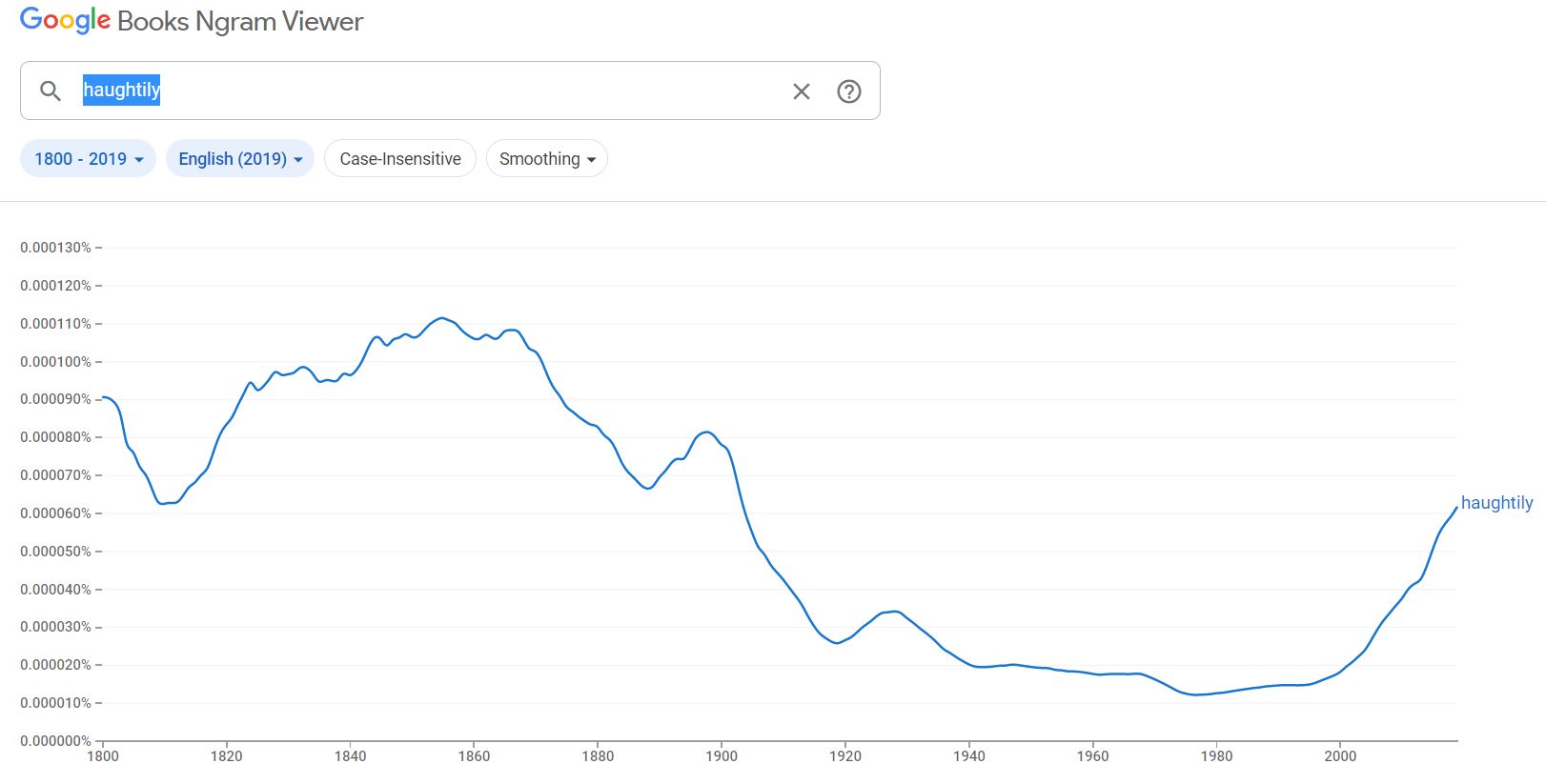
For example, the word “besiege” comprises just 0.0000305% of the published words in Google’s database in 2019. By contrast, the word “the” represents roughly 4.2% of the words in that same database.
The following histogram shows the number of words in each category (note that a lower percentage means a less commonly used, and therefore more difficult, word).

Our analysis shows that the $380 test uses less-common/more difficult vocabulary words than the free test.
To put this data in context, a word like “listless” (from the $380 test) appears approximately 0.000085% of the time while a word such as “clearly” (from the free test) appears approximately 0.0085% of the time. This means that the word “clearly” is 100 times more common!
On average, the $380 test uses words that show up 0.00128% of the time, while the free test uses words that show up 0.00333% of the time. This may not seem like a large difference, but that actually means that the vocabulary that is tested on the free test is more than twice as common as the vocabulary on the $380 test.
Distribution of Nouns, Verbs, and Adjectives on the ISEE Verbal Reasoning Section
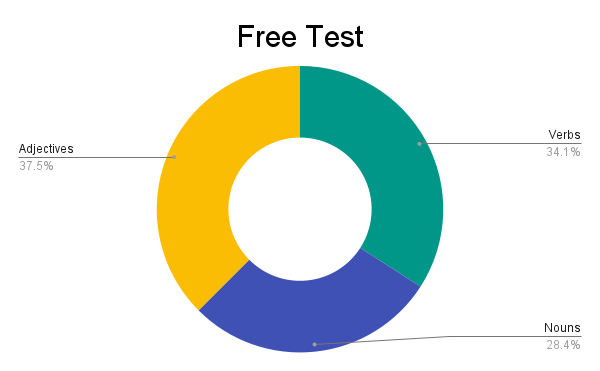
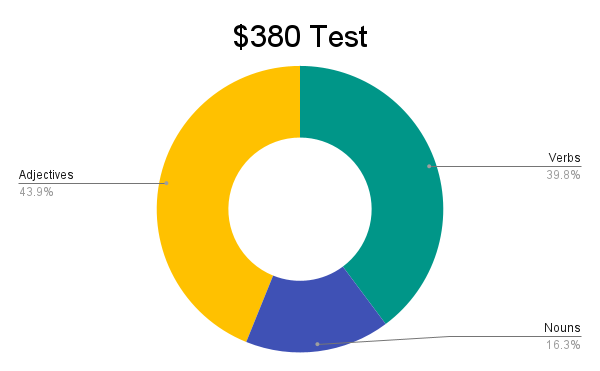
| Part of Speech | Free ISEE Test | $380 ISEE Test | Average |
| Nouns | 28.40% | 16.32% | 22.36% |
| Verbs | 34.10% | 39.78% | 36.94% |
| Adjectives | 37.5% | 43.90% | 40.70% |
Sentence Structure of Fill-in-the-Blank Verbal Reasoning Questions
The ISEE Middle Level test contains only single blank sentence completion questions. The sentences can be broken down by type, which can be helpful in teaching students what key words to look for to better understand what the missing word might be (key words are bolded in the samples below):
- Compare and Contrast – “Unlike other great apes, which are social, orangutans are —– creatures except for playful juveniles and mothers with babies.”
- Similarity – “Many people raise their voices in an argument, as though higher volume —– a greater ability to persuade.
- Cause and Effect – “The article on gene splicing was so —- that only a handful of the students were able to understand it.”
- Definition or Explanation – Poet-novelist Rita Dove, former United States Poet Laureate, was the —- of the 1966 Heinz Award in the category of arts and humanities.”
| Sentence Type | Free ISEE Test | $380 ISEE Test | Average |
| Compare and Contrast | 41.18% | 35% | 38.09% |
| Similarity | 5.88% | 20% | 12.94% |
| Cause and Effect | 23.53% | 20% | 21.77% |
| Definition or Explanation | 29.41% | 25% | 27.21% |
What is Tested on the ISEE Quantitative Reasoning Section?
The second section of the ISEE is Quantitative Reasoning, which lasts 35 minutes and includes 37 multiple-choice questions. Many students consider Quantitative Reasoning to be the most challenging section of the ISEE.
What We Learned from the ERB’s Official Materials for Quantitative Reasoning
- The average question difficulty is a 2.85 out of 5 (see description below).
- Including answer choices, there are 0.44 graphics per question.
- Probability. algebra, and mathematical properties represented the most frequently tested concepts.
We used two metrics to create a 1-5 difficulty scale for the quantitative reasoning math questions.
- Length of time required to read and solve the problem.
- Number of distinct concepts required to solve the problem.
For example, we would rate the single concept question below as a 3 out of 5 for difficulty:
- If 4y – 1 = 7, then what must 8y – 2 equal?
- 2
- 8
- 14
- 16
This problem tests a student’s understanding of algebraic expressions, which is a high-level topic for the Middle Level ISEE. It would take several steps for a student to solve. However, if the student realizes that 8y – 2 is equal to two times 4y – 1, then they can skip most of the algebraic steps involved in the problem. Therefore, this is rated as an average problem for ISEE difficulty.
We would rate this multi-step, multi-concept question as a 5 out of 5 for difficulty:
- A set of 7 numbers has a mean of 9. What additional number must be included in this set to create a new set with a mean that is 3 less than the mean of the original set?
- -15
- -18
- -23
- -39
This is clearly a difficult problem. It requires familiarity with negative numbers and a thorough understanding of number sets and their means. This question is also likely to fluster students because it does not provide them with any of the numbers in the set. As a result, this question is rated as a 5 out of 5.
With the two metrics mentioned above, the average difficulty of the questions from the free test and the $380 test was 2.85 out of 5.
Graphics Make Questions More Manageable
The number of graphics on each test also plays a role in how students understand and interact with the math sections as a whole. Graphics, in our experience, generally aid students to better understand the problem. Of course, graphics are only helpful if a student takes the time to carefully analyze them. If a student works too quickly through a graphic-based problem, then they will often miss critical information for answering the question correctly.
We found that there were 15 graphics in both tests’ Quantitative Reasoning sections. This corresponds to an average of 0.44 graphics per question including the answer choices.
| Free ISEE Test | $380 ISEE Test | Average | |
| Number of Graphics | 15 | 15 | 15 |
| Graphics per Question | 0.47 | 0.41 | 0.44 |
Tested Math Topics and Question Counts on the ISEE Quantitative Reasoning Section
| Category | Free ISEE Test | $380 ISEE Test | Average |
| Balancing Algebraic Equations | 2 | 1 | 1.5 |
| Data Analysis | 3 | 2 | 2.5 |
| Distance, Rate, & Time | 1 | 0 | 0.5 |
| Factors & Multiples | 0 | 0 | 0 |
| Fractions & Decimals | 1 | 4 | 2.5 |
| Function Notation | 0 | 0 | 0 |
| Linear Equations & Their Graphs | 3 | 3 | 3 |
| Mathematic Properties | 6 | 5 | 5.5 |
| Mean, Median, Mode, Range, & Weighted Average | 1 | 1 | 1 |
| Multiplying Polynomials | 0 | 0 | 0 |
| Operations on Algebraic Expressions | 1 | 2 | 1.5 |
| Order of Operations | 0 | 0 | 0 |
| Percentages | 3 | 2 | 2.5 |
| Probability | 3 | 6 | 4.5 |
| Polygons: Angles, Perimeter, Area | 3 | 3 | 3 |
| Quadratic Equations and Their Graphs | 0 | 0 | 0 |
| Ratios and Proportions | 2 | 3 | 2.5 |
| Scientific Notation | 0 | 1 | 0.5 |
| Sequences | 1 | 0 | 0.5 |
| Set Notation | 0 | 0 | 0 |
| Solid Geometry: Surface Area and Volume | 2 | 1 | 1.5 |
| Systems of Linear Equations | 0 | 0 | 0 |
| Triangles: Types and Rules | 0 | 2 | 1 |
What is Tested on the ISEE Reading Comprehension Section?
The third section is Reading Comprehension, which lasts 35 minutes and includes 36 multiple-choice questions, which are evenly distributed among 6 reading passages.
What We Learned from the ERB’s Official Materials for Reading Comprehension
- The average passage length is 412 words across 57 lines.
- The average Fry grade level is 8.73 (eighth to ninth grade).
- The reading passages were overwhelmingly science-based.
| Data Category | Free ISEE Test | $380 ISEE Test | Weighted Average |
| Total Number of Lines | 284 | 339 | 314 |
| Total Number of Words | 2044 | 2484 | 2284 |
| Words per Passage | 408.8 | 414 | 411.64 |
| Fry Readability | 9.4 | 8.17 | 8.73 |
The Fry Readability Graph utilizes sentence length and syllable count as variables and generates a Fry Score in the form of a U.S. reading grade level. The grade level is the predicted level at which an individual needs to be able to read in order to comprehend a text. In addition to the Fry readability test, the following readability metrics were used: Flesch Kincaid Grade Level, Gunning Fog Index, Coleman-Liau Index, Automated Readability Index. These metrics work as follows:
- Flesch-Kincaid Grade Level (FKGL) – FKGL uses a formula that depends on word length (in syllables) and sentence length to predict the grade level of a text.
- Gunning Fog Index (GFI) – Similarly to the Fry Readability graph, GFI uses sentence length and syllable count to generate a corresponding grade level for a text.
- Coleman-Liau Index (CLI) – CLI relies on sentence length and character count (rather than syllable count) to determine a text’s grade level.
- Automated Readability Index (ARI) – Similarly to CLI, the ARI uses sentence length and character count as inputs and outputs the predicted grade level of a text.
Below is a chart comparing the reading level of the $380 test to that of the free test based upon all of the aforementioned indices.
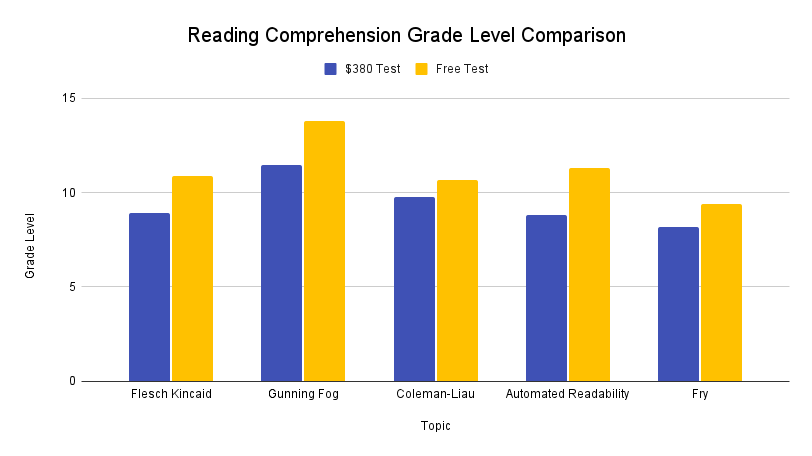
This analysis shows that the reading level of the free test is higher than the the $380 test across all five metrics. This indicates that the Reading Comprehension section is easier on the $380 test. It should be noted that in a similar comparison of the Lower Level and Upper Level tests we found the opposite result: the reading on the $380 test was more difficult than the free test for both levels.
For the Middle Level test it is clear that the reading passages on the free test correspond to a higher grade level than the passages on the $380 test.
Reading Comprehension Subject Matter
The subject matter of the reading passages can also affect difficulty level. For example, narrative fiction passages tend to be more familiar to students and easier for them to digest. Conversely, dry science passages can often be more difficult for students to remain engaged and understand. We split the passage types into 4 main categories:
- Narrative
- Social Science
- Humanities
- Science
| Passage Type | Free ISEE Test | $380 ISEE Test | Average |
| Narrative | 0 | 1 | 0.5 |
| Social Science | 1 | 1 | 1 |
| Humanities | 1 | 1 | 1 |
| Science | 2 | 3 | 2.5 |
ISEE Middle Level Reading Comprehension Question Types
Each of the 6 Reading Comprehension passages is followed by 6 questions. There are six general categories of questions.
- Main Idea – “The primary purpose of the passage is to…”
- Supporting Ideas – “The author caused the larvae to decorate their cocoons with stripes by…”
- Inference – “What probably led the author to experiment with caddis larvae?”
- Vocabulary In Context – “In line 4, “minute” most nearly means?”
- Organization and Logic – “Which best describes the organization of lines 8-17?”
- Tone, Style, and Figurative Language – “The author’s tone when discussing the news media is best described as…”
Our analysis shows that not all types of questions are present for every passage. Supporting Ideas questions occur the most often—more than one per passage—and tone, style, and figurative language questions occur the least often—only making an appearance once on about half of the passages on average.
| Question Category | Free ISEE Test | $380 ISEE Test | Average per Test |
| Main Idea | 20% | 16.67% | 6 |
| Supporting Ideas | 33.33% | 25% | 9.45 |
| Inference | 16.67% | 13.89% | 5 |
| Vocabulary | 13.33% | 19.44% | 5.64 |
| Organization and Logic | 13.33% | 11.11% | 4 |
| Tone, Style, and Figurative Language | 3.33% | 13.89% | 3.18 |
What is Tested on the ISEE Mathematics Achievement Section?
The fourth section is Mathematics Achievement, which lasts 40 minutes and includes 47 multiple-choice questions. Students generally find the Mathematics Achievement section easier than Quantitative Reasoning. However, our analysis shows that while the tested concepts in Mathematics Achievement may be generally easier than Quantitative Reasoning, more steps are often required to find the correct answer.
What We Learned from the ERB’s Official Materials for Mathematics Achievement
- The average question difficulty is a 2.95 out of 5 (see description of methodology above under Quantitative Reasoning).
- Including answer choices, there are 0.39 graphics per question or roughly 11.5% fewer than in Quantitative Reasoning.
- Polygons and arithmetic word problems represented the most frequently tested concepts.
Like the Quantitative Reasoning section, we analyzed the Mathematics Achievement section by looking at:
- Length of time required to read and solve the problem.
- Number of distinct concepts required to solve the problem.
At just 0.39 graphics per question, there are proportionally fewer graphics in Mathematics Achievement than in Quantitative Reasoning.
| Free ISEE Test | $380 ISEE Test | Average | |
| Number of Graphics | 17 | 18 | 17.5 |
| Graphics per Question | 0.41 | 0.38 | 0.39 |
Tested Math Topics and Question Counts on the ISEE Mathematics Achievement Section
As compared to the Quantitative Reasoning section, the Mathematics Achievement section tests a wider range of topics across the board.
| Category | Free ISEE Test | $380 ISEE Test | Average |
| Absolute Value | 0 | 0 | 0 |
| Arithmetic Word Problems | 3 | 5 | 4 |
| Balancing Algebraic Equations | 4 | 0 | 2 |
| Combinations | 0 | 1 | 0.5 |
| Data Analysis | 1 | 0 | 0.5 |
| Distance, Rate, & Time | 0 | 0 | 0 |
| Factors & Multiples | 0 | 4 | 2 |
| Fractions & Decimals | 4 | 4 | 4 |
| Function Notation | 0 | 0 | 0 |
| Inequalities | 0 | 0 | 0 |
| Linear Equations & Their Graphs | 3 | 4 | 3.5 |
| Mathematic Properties | 5 | 1 | 3 |
| Matrices | 0 | 0 | 0 |
| Mean, Median, Mode, Range, & Weighted Average | 1 | 2 | 1.5 |
| Midpoint & Distance Formulas | 0 | 0 | 0 |
| Multiplying Polynomials | 0 | 0 | 0 |
| Number Types | 1 | 0 | 0.5 |
| Number Lines | 0 | 2 | 1 |
| Operations on Algebraic Expressions | 2 | 4 | 3 |
| Order of Operations | 2 | 1 | 1.5 |
| Percent of Change | 0 | 0 | 0 |
| Percentages | 2 | 4 | 3 |
| Permutations | 0 | 0 | 0 |
| Polygons: Angles, Perimeter, and Area | 3 | 5 | 4 |
| Powers & Roots | 0 | 0 | 0 |
| Probability | 1 | 3 | 2 |
| Ratios & Proportions | 3 | 1 | 2 |
| Scientific Notation | 0 | 1 | 0.5 |
| Sequences | 0 | 0 | 0 |
| Solid Geometry: Surface Area and Volume | 1 | 3 | 2 |
| Triangles: Types and Rules | 0 | 1 | 0.5 |
| Trigonometry | 0 | 0 | 0 |
| Types of Angles | 0 | 0 | 0 |
| Units of Measurement | 0 | 0 | 0 |
What is Tested on the ISEE Essay?
The essay is the fifth and final section of the ISEE Middle Level, but it is not scored. Students are allotted 30 minutes to write up to two pages in response to a prompt provided in the test booklet.
Their response is sent directly to schools. Schools will mostly use the essay to get a literally-unadulterated look at a student’s writing ability and thought process.
Take a more thorough look at the ISEE Essay with our ISEE Ultimate Prep Guide and Guide to Preparing for the ISEE Essay.
Prepare for the ISEE Middle Level with Practice Tests
Our opinion is biased, but we don’t think you should spend $380 at Test Innovators just to acquire a single, recycled test from ERB. While the $380 test is slightly more difficult than the free test for Verbal Reasoning, you can understand that difficulty just by downloading last year’s free “What to Expect on the ISEE” that includes excerpts from the $380 test or by taking Piqosity’s practice tests!
Along with our full-length, online ELA and Math courses for grades 6-11, we offer full ISEE test prep courses for the lower, middle, and upper level ISEE, each of which includes several practice exams, dozens of concept lessons, personalized practice software, and more.
If you’re ready to get started, you can try out all of Piqosity’s features with our free community account. With a community account, you have access to two, absolutely free ISEE practice tests! When you’re ready to upgrade, Piqosity’s year-long accounts start at only $89.
More Educational Resources by Piqosity:


